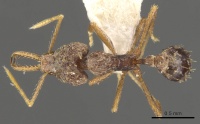Strumigenys manis
| Strumigenys manis | |
|---|---|

| |
| Scientific classification | |
| Kingdom: | Animalia |
| Phylum: | Arthropoda |
| Class: | Insecta |
| Order: | Hymenoptera |
| Family: | Formicidae |
| Subfamily: | Myrmicinae |
| Tribe: | Attini |
| Genus: | Strumigenys |
| Species: | S. manis |
| Binomial name | |
| Strumigenys manis Bolton, 2000 | |
Well collected for a Strumigenys species, this is a rainforest ant is presently known only from litter samples.
Identification
Bolton (2000) - A member of the Strumigenys marginiventris-group. The smallest known species in the group, manis also has the shortest mandibles and scapes and is the only species to possess a preapical denticle in addition to the distal preapical tooth. No other species in the group has a reticulate-punctate postpetiole disc or completely lacks spongiform tissue ventrally on the petiole. In many ways manis resembles Strumigenys boneti (ludia-group) , which is also known from Mexico, but boneti has a strong intercalary denticle and lacks a distal preapical tooth.
Keys including this Species
Distribution
Latitudinal Distribution Pattern
Latitudinal Range: 18.64° to 18.0594866°.
| North Temperate |
North Subtropical |
Tropical | South Subtropical |
South Temperate |
- Source: AntMaps
Distribution based on Regional Taxon Lists
Neotropical Region: Colombia, Mexico (type locality).
Distribution based on AntMaps
Distribution based on AntWeb specimens
Check data from AntWeb
Countries Occupied
| Number of countries occupied by this species based on AntWiki Regional Taxon Lists. In general, fewer countries occupied indicates a narrower range, while more countries indicates a more widespread species. |

|
Estimated Abundance
| Relative abundance based on number of AntMaps records per species (this species within the purple bar). Fewer records (to the left) indicates a less abundant/encountered species while more records (to the right) indicates more abundant/encountered species. |

|
Biology
|
Castes
Nomenclature
The following information is derived from Barry Bolton's Online Catalogue of the Ants of the World.
- manis. Strumigenys manis Bolton, 2000: 542 (w.) MEXICO.
Unless otherwise noted the text for the remainder of this section is reported from the publication that includes the original description.
Description
Worker
Holotype. TL 2.5, HL 0.63, HW 0.52, CI 83, ML 0.42, MI 67, SL 0.46, SI 88, PW 0.30, AL 0.64. Mandible with a minute denticle just proximal of midlength; this denticle extremely small and difficult to see, only a fraction the length of the distal preapical tooth. Cephalic dorsum with 2 pairs of erect short hairs; one near highest point of vertex, the other close to the occipital margin. Apicoscrobal flagellate hair present (abraded in holotype). Pronotal humeral hair flagellate and a pair of flagellate hairs present on mesonotum. All standing hairs on waist segments and on first gastral tergite short and quite stout, simple to feebly remiform and curved or inclined posteriorly. Sides and dorsum of alitrunk densely reticulate-punctate everywhere; disc of postpetiole completely reticulate-punctate. First gastral tergite behind basigastral costulae more superficially reticulate-punctate than postpetiole, the surface weakly shining. Propodeal spines long and narrowly triangular, stoutly constructed and subtended by a narrow carina down the declivity. Ventral surface of petiole without a spongiform crest or curtain but with a small rounded cuticular process anteriorly. Lateral lobe of petiole feebly developed, scarcely more than an extension of the posterior collar onto the side of the node.
Type Material
Holotype worker, Mexico: Vera Cruz, Tuxtias, 10 km. NNW Sontecomapan, 18°35'N, 95°05'W, 200 m., 20.iii.1985, sifted litter (leaf mold, rotten wood), rainforest, #7333-18 (P. S. Ward) (The Natural History Museum).
References
- Bolton, B. 2000. The ant tribe Dacetini. Memoirs of the American Entomological Institute. 65:1-1028.
- Guerrero, R.J., Fernandez, F., Escarraga, M.E., Perez-Pedraza, L.F., Serna, F., Mackay, M.P., Sandoval, V., Vergara, V., Suarez, D., Garcia, E.I., Sanchez, A., Meneses, A.D., Tocora, M.C., Sosa-Calvo, J. 2018. New records of myrmicine ants (Hymenoptera: Formicidae) for Colombia. Revista Colombiana de Entomología 44: 238-259 (DOI 10.25100/socolen.v44i2.7115).
References based on Global Ant Biodiversity Informatics
- Ahuatzin D. A., E. J. Corro, A. Aguirre Jaimes, J. E. Valenzuela Gonzalez, R. Machado Feitosa, M. Cezar Ribeiro, J. Carlos Lopez Acosta, R. Coates, W. Dattilo. 2019. Forest cover drives leaf litter ant diversity in primary rainforest remnants within human-modified tropical landscapes. Biodiversity and Conservation 28(5): 1091-1107.
- Bolton, B. 2000. The Ant Tribe Dacetini. Memoirs of the American Entomological Institute 65
- Dattilo W. et al. 2019. MEXICO ANTS: incidence and abundance along the Nearctic-Neotropical interface. Ecology https://doi.org/10.1002/ecy.2944
- Longino J. et al. ADMAC project. Accessed on March 24th 2017 at https://sites.google.com/site/admacsite/
- Vásquez-Bolaños M. 2011. Lista de especies de hormigas (Hymenoptera: Formicidae) para México. Dugesiana 18: 95-133

